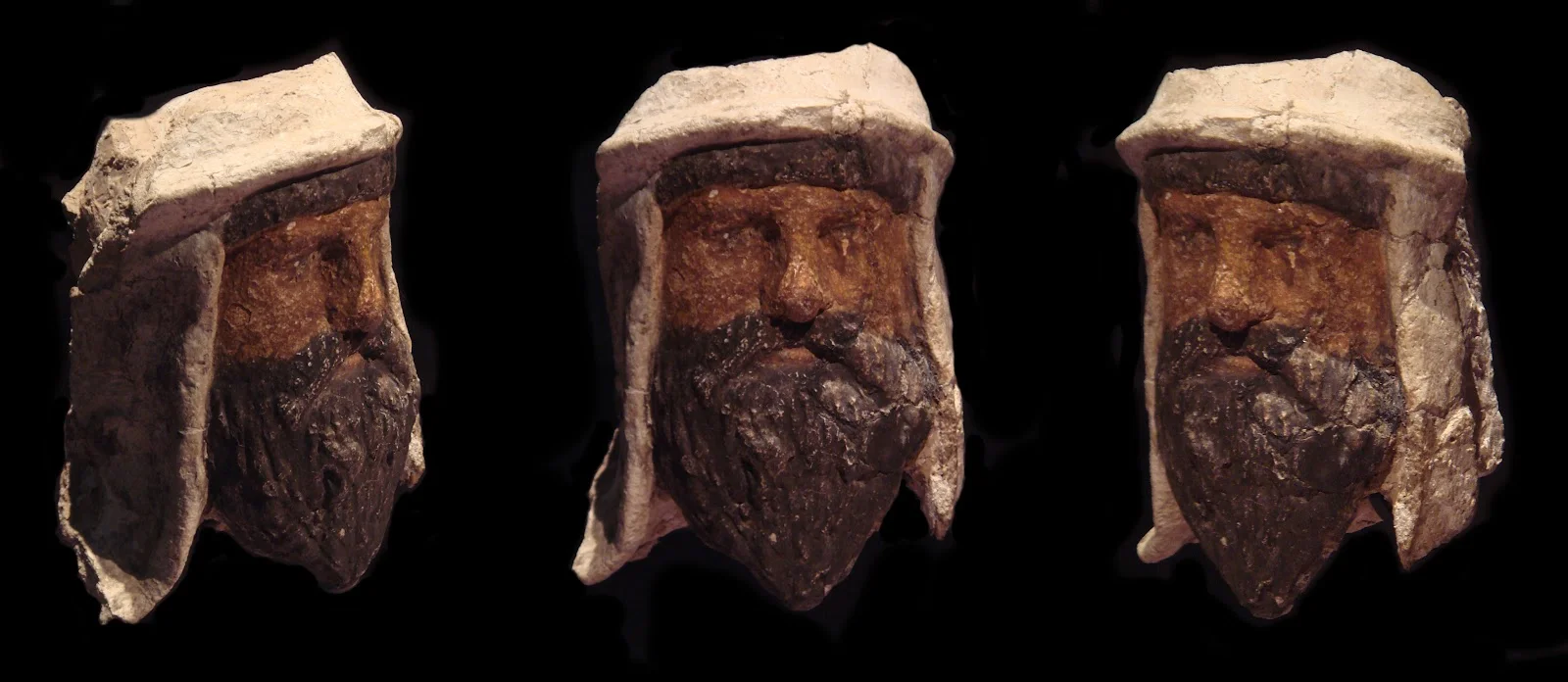For centuries, the Sogdians of Central Asia played a pivotal role in the cultural, commercial, and religious exchanges along the Silk Road, acting as key intermediaries between the East and West. Through trade, translation, and travel, they played a crucial role in spreading ideas, technologies, and faiths across Eurasia, leaving a lasting impact on the region’s cultural identity.
Sogdiana at the Crossroads
For the first fifteen centuries of the Common Era, and perhaps even earlier, the Central Asian region of Sogdiana (also known as Sughd) was an integral part of the trans-Asian network of overland trade routes that would become famous as the Silk Road. Situated near the intersection of the main routes between East and West and the southern spurs leading into South Asia, Sogdiana occupied a central position between the Mediterranean world, China, and India. The Sogdians were, therefore, exposed to the full range of cultural interactions made possible by the Silk Road, and many of them—principally merchants and missionaries—were agents of these interactions.
It is no coincidence that throughout history, ideas and technologies have spread along trade routes, and that merchants have been among their primary transmitters. One only has to think about it to realize that traveling businessmen do not simply convey, sell and acquire goods, and move on. They socialize, interact, and observe while they are on the road, taking their impressions home with them.
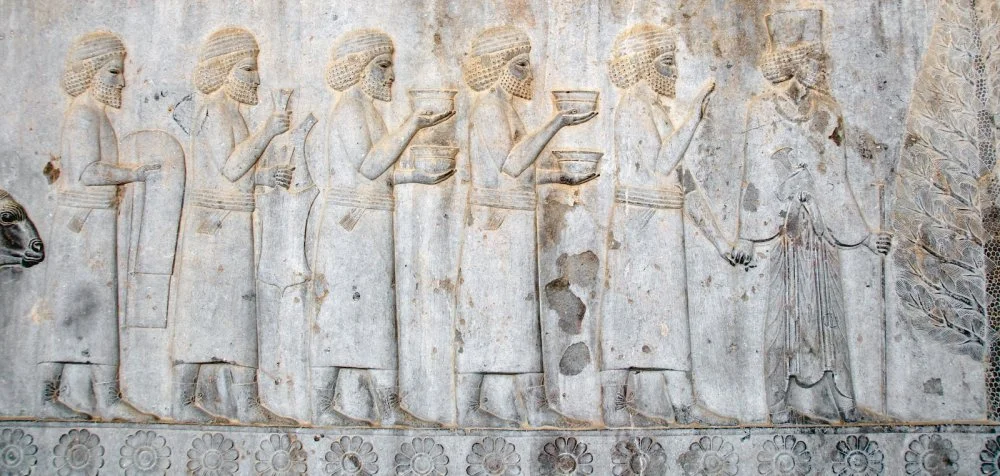
Bas-relief of Sogdian tribute bearers on the Apadana staircase (audience hall), Persepolis, Iran. Achaemenid period, 5th century BCE / Wikimedia Commons
The existence of trade routes and the constant commercial activity between diverse cultures from ancient times meant that religious ideas (along with technology and other aspects of culture) could easily spread along the vast trade networks that spanned Eurasia. Indeed, like running water finding open channels, this dissemination was likely inevitable. But the religion–trade relationship was mutually reinforced. For example, the expansion of Buddhism brought an increased demand for silk, which was used in Buddhist ceremonies, thus further stimulating the long-distance trading activity that had facilitated the spread of Buddhism in the first place.
Caravans and the Spread of Religions
The oases of the Silk Road—Marv, Balkh, Bukhara, Samarkand, Kashgar, Turfan, Khotan, Kucha, and others—owed their prosperity, and often their very existence, to the caravans passing by regularly. They offered way stations, or caravanserais (in Persian kārvānsarāy), where large numbers of travelers could stop and rest for a night or more, stock up on food and supplies, buy local goods, and sell the locals imported ones. Caravan traffic existed primarily by and for long-distance trade. For the most part, nobody but a merchant would have the means, the motivation, or the mettle to undertake travel when its conditions were so rigorous and outcome so uncertain. This also explains why it was mainly goods of high value in proportion to the bulk that were carried along the Silk Road: one had to stand to make a considerable profit from his wares for such a daunting endeavor to seem at all worthwhile.
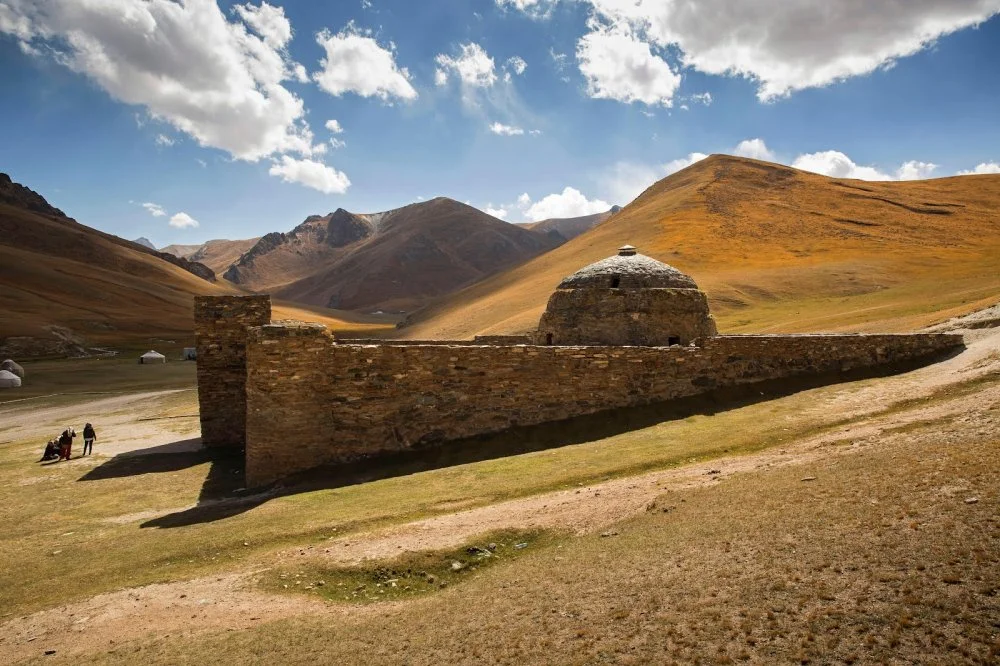
Caravanserai Tash Rabat at the old Silk Road, Kyrgyzstan, Naryn/Alamy
Nevertheless, not everyone joined caravans for purely commercial reasons. Diplomatic missions often traveled with them, and people with special talents, or those who thought they possessed them, would travel to distant courts in search of patronage. A few hardy souls traveled merely to satisfy their own curiosity, while others had scholarly interests, and traveled for the sake of research and learning.
For the most part, merchants and other travelers along the Silk Road were linguistically Iranians, whether Persian, Parthian, Bactrian, or Sogdian. They could be Zoroastrian, Jewish, Buddhist, Christian, Manichaean, or Muslim. Mentions in Chinese sources of ‘Westerners’ (usually referred to as ‘Hu’) can, thus, mostly be taken as referring to individuals of Iranian background.
Religious Diversity and Linguistic Influence
Among the various Iranian-speaking peoples who traveled the Silk Road frequently, the Sogdians were the most important, as evidenced by the fact that the Sogdian language served as the Silk Road’s primary lingua franca up to the time of the Arab conquests. For centuries, Sogdian merchants were among the most successful in Asia, and their trading activities formed the major link connecting the East and West. They were carriers of cultural artifacts as well as responsible for cross-pollinating ideas and traditions from one civilization to another.
It is often claimed that the Sogdians’ religion in ancient times was Zoroastrianism, but there is little concrete evidence for this. It is more likely their religious beliefs and practices were drawn from the broader pool of old Iranian religious practices, including a range of local deities and hero cults. The cult of Siyavash in the Bukhara region and the popularity among the Sogdians of the imported Mesopotamian goddess Nanai are good examples of this. The pan-Iranian new year celebration, Nowruz, associated with the vernal equinox, also likely originated in Mesopotamia.
As for Zoroaster himself, the exact place and time of his life are not known. He may have lived in Central Asia sometime before the first millennium BCE, but the religion known as Zoroastrianism was not formally established until much later, during the Sasanian period (224–651 CE). Nevertheless, ancient fire temples suggest the presence of at least some religious practices that were included in Zoroastrianism in Central Asia. Iranian merchants brought these practices to China, where their temples are mentioned in Chinese sources. On the other hand, Sogdian relics from China attest to non-Zoroastrian religious elements, such as the worship of the goddess Nanai.
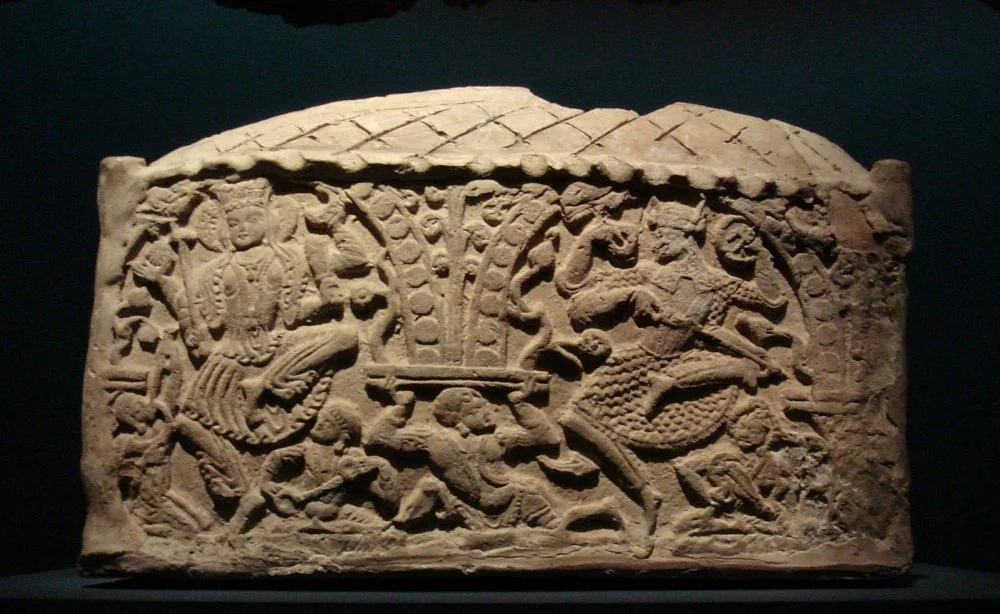
Zoroastrian funerary vessel from Hirman Tepe, Uzbekistan. 7–8 century CE / Wikimedia Commons
The rise of proselytizing religions brought with it the emergence of missionaries. First the Buddhists, then the Christians and Manicheans, and finally the Sufi Muslims latched onto caravans that would take them and their ‘spiritual goods’ into new lands. As new religious traditions carried by the Silk Road went eastward and took root along the way, travelers were increasingly able to find co-religionists in even the most far-flung and out-of-the-way places to provide them with assistance and fellowship, and to whom in return they could bring some contact (and often cash donations) from the outside world.
The spread of religious traditions across Asia also encouraged the practice of pilgrimage. For example, once Buddhism had established itself in China, Buddhists from that country began to feel the need for direct contact with the sources of their traditions in India. Chinese monks, the most famous of whom are Faxian in the fifth century and Xuanzang in the seventh, traveled the Silk Road through Central Asia and down into the Indian subcontinent. Over time, Korean and Japanese Buddhist pilgrims also appeared. And by the thirteenth century, Christian Turks from Mongolia, such as Rabban Sauma and his disciple Markos, were undertaking the pilgrimage west to Palestine and beyond.

Palm Sunday (probably). Fresco from the Nestorian temple in Qocho, China. 683–770 CE. Museum of Asian Art, Berlin / Wikimedia Commons
From the tenth century or even earlier, Sufi masters attached themselves to Silk Road caravans to spread their often esoteric interpretations of Islam eastward into Inner Asia and China. They frequently won large local followings, converting people more by their own personal charisma than through the canonical teachings of the faith. Often such figures were attributed with miraculous powers, and when they died their disciples would typically erect a shrine in their honor, which might later become a focus of pilgrimage.
However, it was not only, or even primarily, through missionary activity that religious ideas spread along the Silk Road. The earliest of the ‘mobile’ religious systems to take this eastward path, the Iranian and the Jewish, were not proselytizing faiths. Even the later ‘missionary’ religions won converts at least as much through their prestige as foreign, cosmopolitan traditions as they did through active proselytization. It is surely no coincidence that the periods in which Buddhism, Manichaeism, and Nestorian Christianity experienced their most active spread through Central Asia were connected with the adoption of their traditions by merchant communities.
With their international connections, Sogdian merchants knew foreign languages, and uncharacteristically for the time, some were even literate. That’s how they often came to work as interpreters and translators. It was Sogdian scribes who translated most of the religious texts of Buddhism, Manichaeism, and Christianity into the various languages of the Silk Road from Indian prakrits (vernacular dialects), Aramaic, or Parthian into Bactrian, Tokharian, Khotanese, Turkish, or Chinese, either via Sogdian or directly. For that matter, it was the Sogdians who brought the technology of paper production from China to the West; well into the Islamic period, their capital, Samarkand, was known throughout the world for the quality of its paper.

Ambassadors from various countries (China, Korea, Iranian and Hephthalite principalities…) paying homage to King Varkhuman and possibly Western Turkic Khagan Shekui, under the prominent presence of Turkic officers and courtiers. Mural on the west wall of the “Hall of Ambassadors” in the Afrasiab palace, Samarkand. 648–651 CE. Afrasiab Museum, Samarkand / Wikimedia Commons
Israelite communities likely existed in Sogdian lands from as early as the eighth century BCE, having been relocated forcibly following the conquest of their kingdom by the Assyrians. Their numbers were supplemented by immigration to Central Asia in the wake of the Persian conquest of Babylon in 539 BCE. These were likely the ancestors of the present-day Jewish communities of Samarkand and Bukhara. Iranicized Jews from Sogdiana were also active along the Silk Road; they established Jewish colonies in China as much as 2,000 years ago. Interestingly, the first written evidence of the post-Islamic ‘New Persian’ language that eventually replaced Sogdian are business documents written in the Hebrew alphabet, found at Dunhuang and dating to the eighth century.

The Buddhas of Bamiyan, Afghanistan. Monumental rock-cut statues created in the 6th century CE and destroyed by the Taliban in 2001. Photograph, 1960 / Getty Images
In the centuries immediately before the Common Era, Buddhism took hold among the Bactrians, a neighbouring Iranian people living to the northwest of India in what is now Afghanistan. According to a legend preserved in Pali, the language of the Theravada canon, Silk Road merchants began spreading the Buddha’s teaching even in his lifetime. This legend relates that two brothers from Bactria (medieval Balkh, in the north of Afghanistan), named Tapassu and Bhallika, visited the Buddha in the eighth week after his enlightenment and immediately became his disciples. According to the story, the brothers then returned to Bactria and built temples dedicated to the Buddha.
While there is no evidence to confirm the legend of Tapassu and Bhallika, edicts inscribed on rock pillars set up by the Indian emperor Ashoka several centuries later state that he sent missionaries into his northwestern territories.
Over the following centuries Bactria did become a major Buddhist region and remained so up to the Muslim conquests. In the seventh century, on the eve of the Arab invasions, the Chinese Buddhist pilgrim Xuanzang found that Balkh had some 100 Buddhist monasteries and 3,000 priests.

Group of Jewish boys with their teacher. Samarkand. Photo by Sergey Prokudin-Gorsky, 1905–1915 / Library of Congress
A Buddhist temple from the same period has been found at Ajina-Tepe in southern Tajikistan. Buddhist monasteries received substantial donations from business travelers and controlled large tracts of productive land, such that by the time of Xuanzang, they made up the major economic nodes of the Silk Road. Sogdians living or trading in Bactria adopted Buddhism and spread its teachings throughout their trading colonies all along the Silk Road, as far as China.

Reclining Buddha from Ajina Tepe, Tajikistan. A monumental 13-meter-long statue created in the 7th century CE and discovered in 1966. Currently exhibited at the National Museum of Antiquities of Tajikistan in Dushanbe/Alamy
During the third century CE, a new religion, Manichaeism, appeared in Mesopotamia. Its founder, Mani, was of Parthian origin. Drawing on Zoroastrian, Christian, and Buddhist ideas, Manichaeism was brought to Central Asia by missionaries such as Mar Ammo. Samarkand became a major Manichaean centre, and from there, the religion spread to China, where it survived up to the seventeenth century. Significant numbers of Sogdians also adopted Christianity, particularly the Nestorian version, which existed in Central Asia up to the time of Timur in the fourteenth century.
The Rise of Islam in Central Asia
During the eighth century, Muslim armies based in Khurasan, composed of Arab settlers and native Iranian converts, gradually conquered and absorbed the Sogdian lands in Central Asia and brought them under the Muslim empire under the caliph of Baghdad. First the ruling elite and aristocracy, then over time the general population, converted to Islam in increasing numbers, to such an extent that since the fifteenth century, the native sedentary population of Central Asia has been almost completely Muslim.
It would seem that even before Muslim power was fully consolidated in Central Asia, Sogdian merchants were among the earliest and most enthusiastic converts to the new religion. The practical element lurking beneath this trend is not hard to see. Muslims had taken over control of the trade networks that connected Central Asia with the Mediterranean world. If Sogdian traders wished to maintain business in that direction, the advantages of being part of the dominant tradition were obvious. Once their own Central Asian homeland had come under Muslim rule and Islamic law as well—a process that took several centuries and was marked by local rebellions led by nativist religious figures—merchants would have had particular incentives not to cling to the old ways.
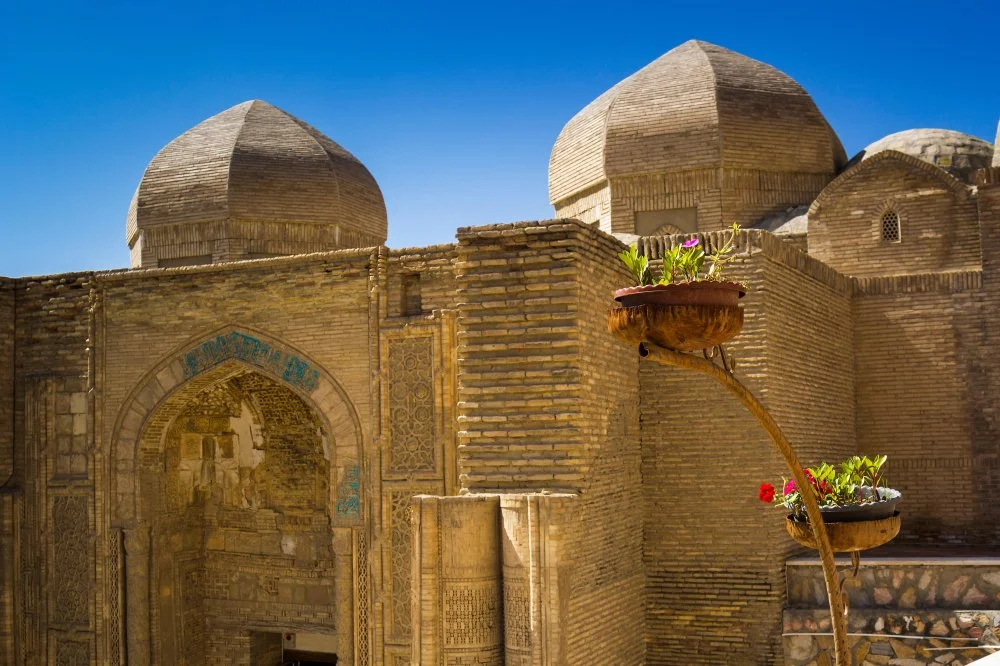
Magok-i-Attari Mosque, Bukhara, Uzbekistan. Originally built in the 9–10 centuries on the site of a Zoroastrian temple, reconstructed in the 12th century, with additional elements added in the 16th century / Alamy
As the Central Asian Sogdians gradually turned to Islam, this led to the conversion of their fellow Sogdian trading partners farther east. This, in turn, facilitated the participation of non-Sogdian Muslims in the Sogdians’ trading activities beyond the pale of Muslim rule, so that when Islam came to China it was not only Sogdian but also Persian and Arab Muslims who were its bearers. Thus, from the eighth century onward, the Sogdians and others in Central Asia adopted Islam and became active participants in the formation of Muslim culture.
The Persianate Transformation
It should be remembered that Islam came to Central Asia through the filter of Iranian civilization, which it had already absorbed and which was its most prominent non-Arab influence. The Arab Muslims’ most dramatic accomplishment was the defeat and absorption of the Sasanian Empire during the 640s. In 750, the Abbasid revolution displaced the center of Muslim power and administration eastward into the Iranian world. The new Abbasid Empire then, in many respects, merely maintained the preexisting Iranian cultural and political realities under a new Islamic identity. Islam became increasingly Iranian in character: Islamic law, philosophy, literature, art, and mysticism all developed to a large extent in the Persian-Tajik cultural sphere.
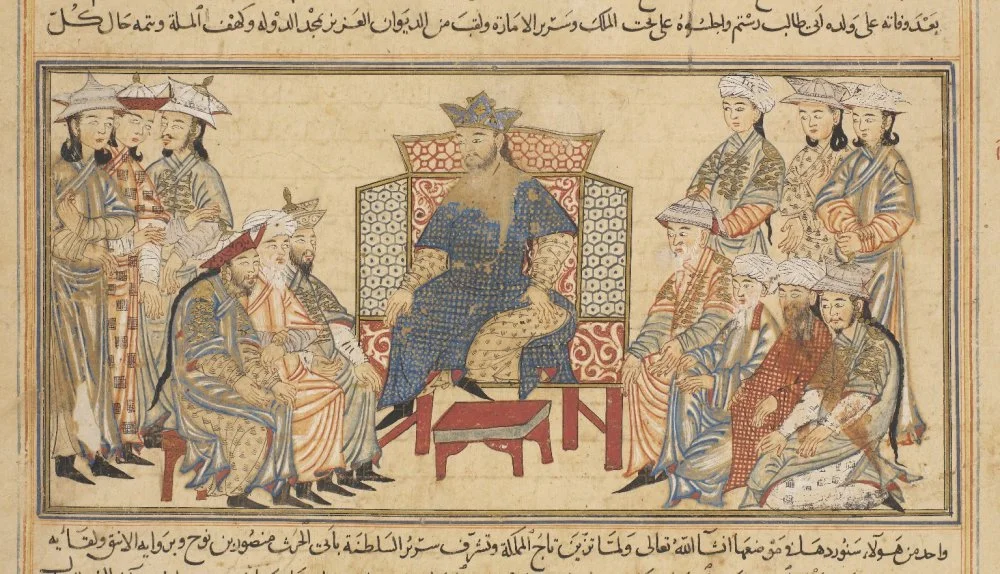
Rashid al-Din. Mansur I ibn Nuh succeeds his father Nuh ibn Nasr in 961. Miniature from the Jami’ al-tawarikh. Circa 1307 / Wikimedia Commons
Over the next several centuries, it was a very Iranicized form of Islam that spread and transformed Sogdiana. It was mainly in the ‘new Persian’ language that Islamic religion and Muslim culture were communicated to Sogdians and other Central Asians. Just as in Egypt and Syria, the local Semitic languages gradually gave way to Arabic, in Central Asia, Sogdian and other local languages ceded to New Persian. Although Central Asia had been incorporated at times into previous Iranian empires, from the Achaemenids to the Parthians to the Sasanians, it was under Muslim rule that local identity became largely subsumed as Central Asia became an integral part of the Persianate world.
Indeed, by the tenth century, a new Persianate dynasty based in Bukhara, the Samanids, had made Central Asia the center of the Islamic world, and it would remain that way through the Timurid period five centuries later. This period can be considered a kind of disguised Sogdian revival, with the east Iranian speakers of Central Asia, now known as the Tajiks, being linguistically assimilated to the broader Persian-speaking world and religiously to the even larger cultural sphere of Islam.
Like water flowing freely, the exchange of culture and beliefs across Eurasia was inevitable, but it was the Sogdians who, for centuries, kept those channels open. Though their name may have faded from popular memory, their legacy remains deeply rooted in the commercial dynamism, religious pluralism, and cultural richness of Central Asia, a subject we will explore later.
